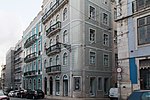Palace of the Counts of Azambuja
Palaces in LisbonProperties of Public Interest in Portugal

The Palace of the Counts of Azambuja (Portuguese: Palácio dos Condes da Azambuja), alternately the Palace Valada-Azambuja (Portuguese: Palácio Valada-Azambuja) is a 16th-century Portuguese estate manorhouse/palace situated in the civil parish of Misericórdia, municipality of Lisbon.
Excerpt from the Wikipedia article Palace of the Counts of Azambuja (License: CC BY-SA 3.0, Authors, Images).Palace of the Counts of Azambuja
Largo do Calhariz, Lisbon Bairro Alto (Misericórdia)
Geographical coordinates (GPS) Address External links Nearby Places Show on map
Geographical coordinates (GPS)
| Latitude | Longitude |
|---|---|
| N 38.710833333333 ° | E -9.1461111111111 ° |
Address
Palácio Valada-Azambuja
Largo do Calhariz 15
1200-106 Lisbon, Bairro Alto (Misericórdia)
Portugal
Open on Google Maps







